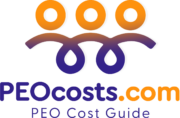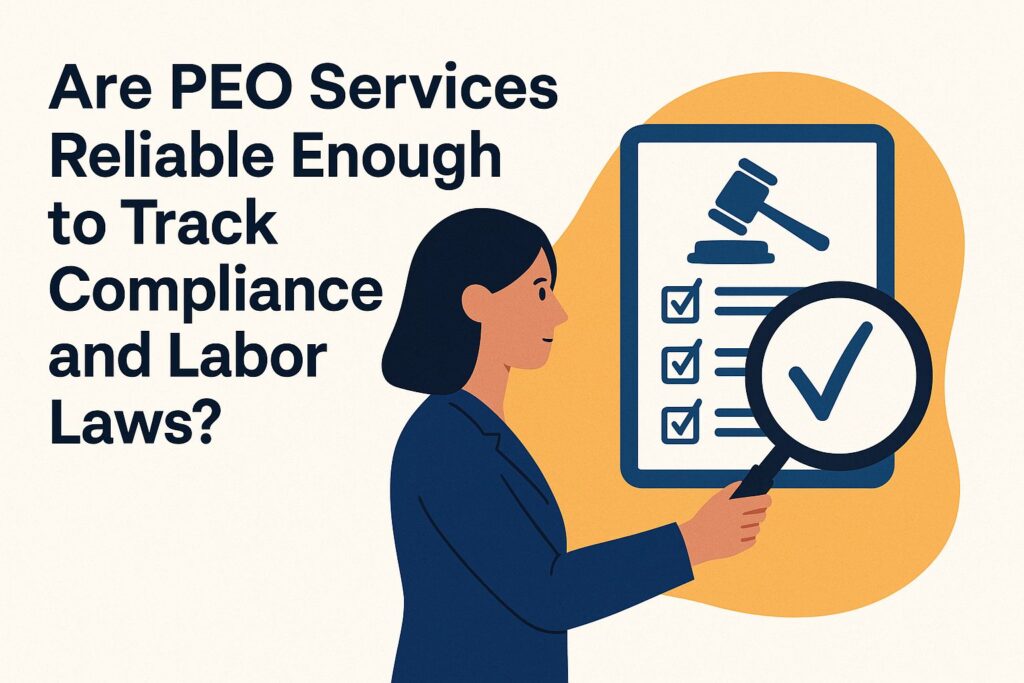
Are PEO Services Reliable Enough to Track Compliance and Labor Laws?
Dealing with compliance and labor laws can be tricky. As a business owner, you need reliable support to avoid costly missteps. PEO services promise to simplify this challenge, but how dependable are they? Learn about Professional Employer Organizations, their part in handling compliance, and consider their advantages and disadvantages. Are these services the safety net you’ve been looking for, or do they come with hidden traps? Let’s explore.
Definition of PEO (Professional Employer Organization)
A Professional Employer Organization (PEO) is a business that handles all HR tasks by sharing employee management responsibilities with client companies, offering complete HR outsourcing.
PEOs help simplify complex compliance issues, such as labor laws, employment regulations, and tax compliance. For instance, they can manage payroll, ensuring you meet federal and state tax obligations, while also providing access to employee benefits like health insurance and retirement plans.
PEOs can often get lower insurance rates by combining the needs of many clients. This cuts expenses for businesses and lowers risks linked to managing employees, letting you concentrate on main activities.
Overview of PEO Services Offered: Workforce Management and Legal Compliance
PEOs provide services like handling payroll, leasing employees, managing benefits, and managing risks to make business operations smoother.
Payroll processing is one of the main services, ensuring that employees are paid correctly and on time, while filing taxes properly to avoid legal problems and maintain operational compliance.
Managing employee benefits through effective benefit administration helps companies offer attractive health options that are important for retaining staff, ensuring strategic planning aligns with business compliance.ADP TotalSource, for example, provides flexible health plans.
Employee leasing can significantly decrease recruiting costs by allowing PEOs to handle staff management, as seen with TriNet.
Risk management services help mitigate workplace safety concerns, employment law issues, and compliance issues, offering a safety net for growing businesses focused on risk mitigation.
These combined services result in more efficient operations and better adherence to rules.
The Importance of Compliance and Labor Laws: Ensuring Business Strategy Aligns with Employer Responsibilities
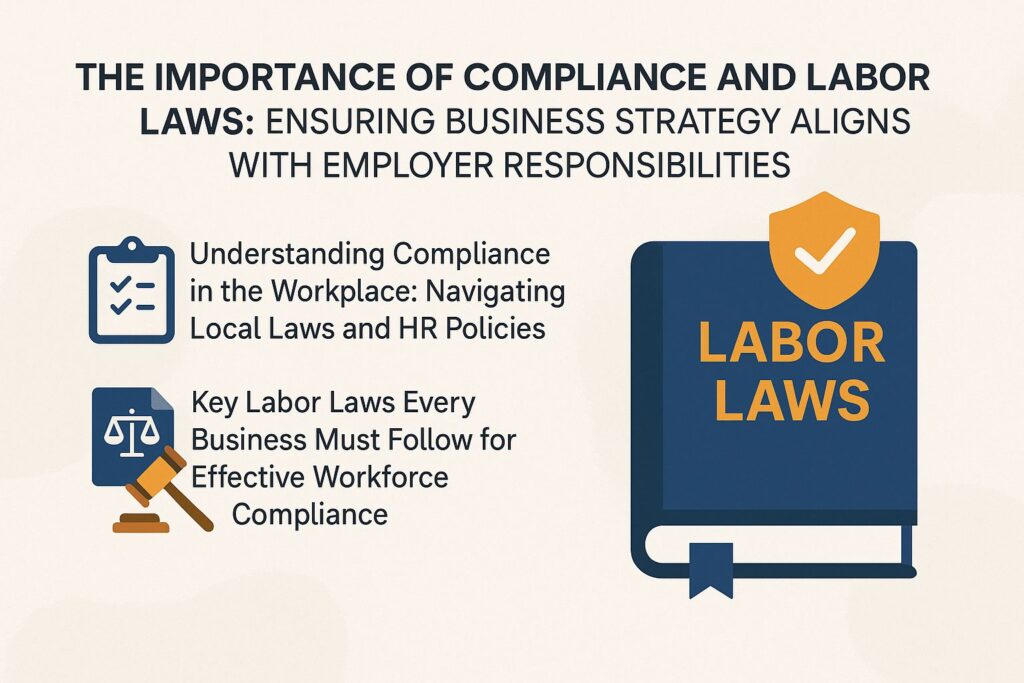
Knowing labor laws and employment rules is important for businesses to analyze risks, lower them, and avoid fines that could be very expensive. For a comprehensive approach, consider examining our Labor Law Compliance Checklist: Is Your Business at Risk? to ensure your business policies are aligned with legal requirements.
Knowing Compliance in the Workplace: Following Local Laws and HR Policies
Compliance in the workplace means following federal and state laws and respecting employee rights. This helps meet legal responsibilities and reduces legal risks, while encouraging responsibility.
To effectively manage workplace compliance, businesses should focus on key elements such as employee classification and payroll regulations.
Start by clearly defining roles to avoid worker classification errors and misclassification; resources such as IRS guidelines can aid this process in maintaining compliance tracking.To follow payroll rules, consider using services like Gusto. They handle payroll calculations and keep accurate records, lowering the risk of audits.
Regularly checking your employment policies against current labor laws keeps your organization compliant, protects employee rights, and creates an open and responsible workplace that values diversity.
Important Labor Laws Businesses Need to Follow for Workforce Compliance
Critical employment regulations such as the Fair Labor Standards Act (FLSA) and the Family and Medical Leave Act (FMLA) form the foundation for employee rights and employer responsibilities, shaping labor relations and contract management.
Knowing important labor laws is necessary to follow regulations. The FLSA requires that workers are paid at least a minimum wage and receive overtime pay to support fair earnings. Non-compliance can lead to hefty fines.
The FMLA allows eligible employees up to 12 weeks of unpaid leave for specific family or medical reasons, with reinstatement rights upon return. Employers must notify employees of their rights under these laws, usually within a set timeframe.
To make managing human resources rules easier, think about using software like Zenefits or Gusto. These programs help manage HR tasks and improve the analysis of HR information. Related insight: Labor Law Compliance Checklist: Is Your Business at Risk? explores the critical steps businesses must take to avoid costly non-compliance issues.
How PEOs Manage Compliance
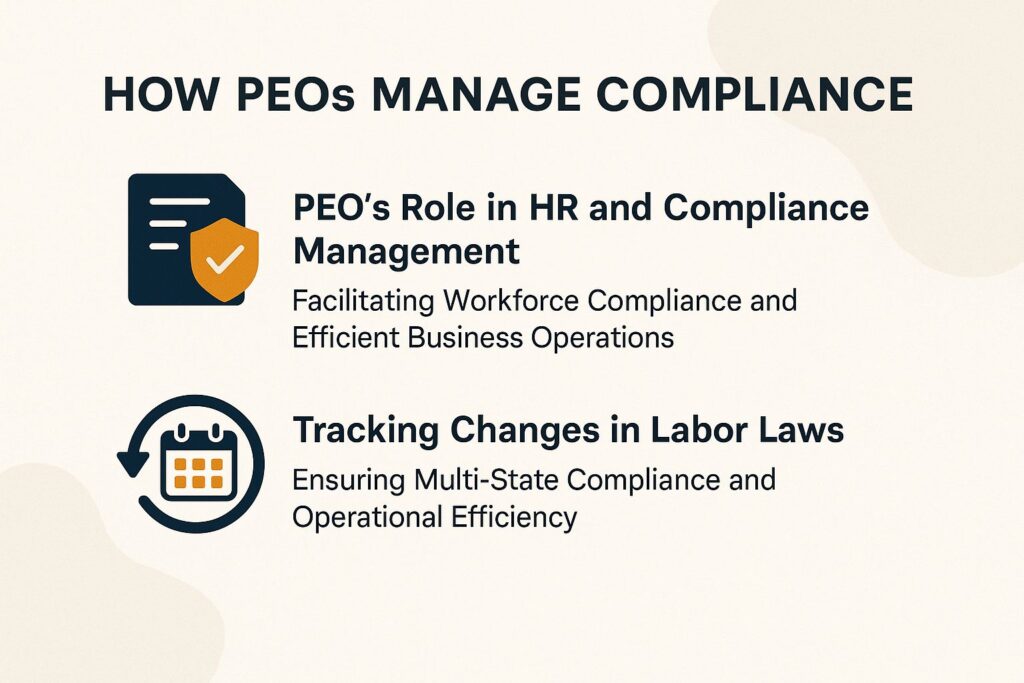
PEOs are important for handling compliance because they know a lot about labor laws and work rules. They keep up with changes in regulations to make sure business partnerships follow the rules.
PEO’s Role in HR and Compliance Management: Facilitating Workforce Compliance and Efficient Business Operations
PEOs act as a co-employer, handling HR functions including compliance management, allowing businesses to focus on core activities.
They simplify payroll processing with software that manages calculations, tax deductions, and filing, making sure everything is correct and timely.
PEOs use their buying power to provide health insurance plans at competitive rates. These are plans that small businesses might have difficulty getting on their own. This helps with looking after employees and using good HR practices.
PEOs handle tasks by frequently updating rules, making sure everything is compliant, and carrying out checks. For example, they give advice on labor laws and assist with OSHA rules to make sure safety standards are met in the workplace.
This help allows businesses to reduce risks, thoroughly research, and prevent fines, so they can focus on expansion, planning strategies, and involving employees.
Tracking Changes in Labor Laws: Ensuring Multi-State Compliance and Operational Efficiency
A good PEO will monitor labor law changes and inform clients, helping businesses stay compliant and avoid fines while improving how they operate.
To do this, a PEO might use legal databases such as Westlaw or LexisNexis to keep informed about state and federal regulations. They often subscribe to compliance tools such as ComplyRight to receive real-time alerts on labor law changes.
It’s essential to share these updates with clients through newsletters or dedicated client portals. This way, the PEO keeps companies updated and gives clear instructions to make required changes, protecting them from possible legal problems and penalties.
Reliability of PEO Services: Assessing Business Risks and Ensuring Service Providers Deliver HR Solutions
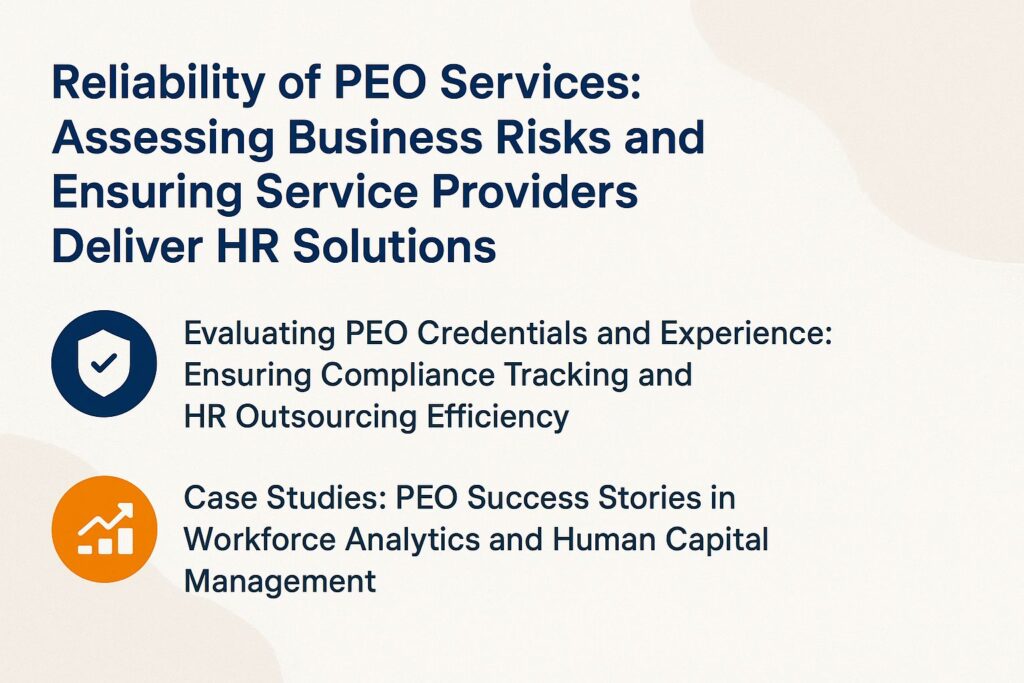
It’s important to verify that PEO services are reliable to make sure they can properly manage your company’s HR tasks and meet legal requirements. For an in-depth understanding, one of our most insightful case studies provides a comprehensive look at top-rated PEO companies and their service offerings.
Evaluating PEO Credentials and Experience: Ensuring Compliance Tracking and HR Outsourcing Efficiency
When choosing a PEO, evaluating their credentials, including certifications such as the Employer Services Assurance Corporation (ESAC) accreditation, is essential.
Look at their professional experience, ability to monitor compliance, and feedback from clients, along with certifications. For instance, a PEO specializing in the construction sector may understand compliance and labor laws better than a generalist firm.
It’s important to examine Service Level Agreements (SLAs) as they define contract management responsibilities and response timelines, ensuring clear expectations from the service provider.
Talking directly with your current clients can help you understand how happy they are and identify any problems, helping you choose the best PEO for your business needs.
Case Studies: PEO Success Stories in Workforce Analytics and Human Capital Management
Examining successful case studies of businesses that partnered with PEOs showcases the tangible benefits of their services in compliance and efficiency.
For instance, a mid-sized manufacturing company decreased its HR-related penalties by 40% after engaging with a PEO. They gained from simplified payroll handling and complete compliance training programs.
Another case involves a tech startup that reported a 25% increase in employee satisfaction, credited to improved benefits administration and access to professional development resources, highlighting the impact of effective HR outsourcing.
By hiring outside help for HR tasks, these companies made their processes more efficient, improved workplace conditions, and showed the advantages of working with a PEO in planning and running the business.
Possible Problems with PEOs: Managing Contract Workers and Making Sure Compliance Software Works Well

Though PEOs offer many advantages, companies might encounter challenges that impact service providers’ effectiveness in ensuring compliance software efficiency and HR technology integration.
Common Pitfalls in PEO Services: Addressing Document Management and Employee Status Concerns
Businesses may face pitfalls including unclear service agreements, ineffective communication, and document management issues, potentially diminishing the value of PEO partnerships.
Common pitfalls include:
- failing to read fine print in contracts, which can result in unexpected fees;
- bad communication, causing confusion about what is expected;
- and inadequate onboarding support, leaving employees confused about benefits.
To handle these issues, get legal advice for reviewing job contracts, set up regular meetings with the PEO to make goals clear, and focus on thorough onboarding procedures.
Be vigilant for hidden costs or unexpected charges in service fees that can accumulate over time, affecting your overall business strategy and budget.
Limitations of PEO Compliance Tracking: Ensuring HR Analytics and Employment Law Adherence
Despite their advantages, PEOs may face limitations in compliance tracking, including reliance on outdated systems, inadequate HR analytics, and insufficient staff training in employment law adherence.
To address these issues, organizations should invest in regular compliance audits to identify gaps in compliance tracking and performance tracking processes.For example, having reviews every three months can confirm that our systems are up-to-date and functioning effectively.
Strong employee training programs are important. Training sessions on current compliance rules can help employees use the PEO’s resources more effectively.
Using these methods together can greatly improve the team’s adherence to rules and keep everyone updated.
Comparing PEOs with In-House HR Compliance: Evaluating Business Risks and Workforce Analytics
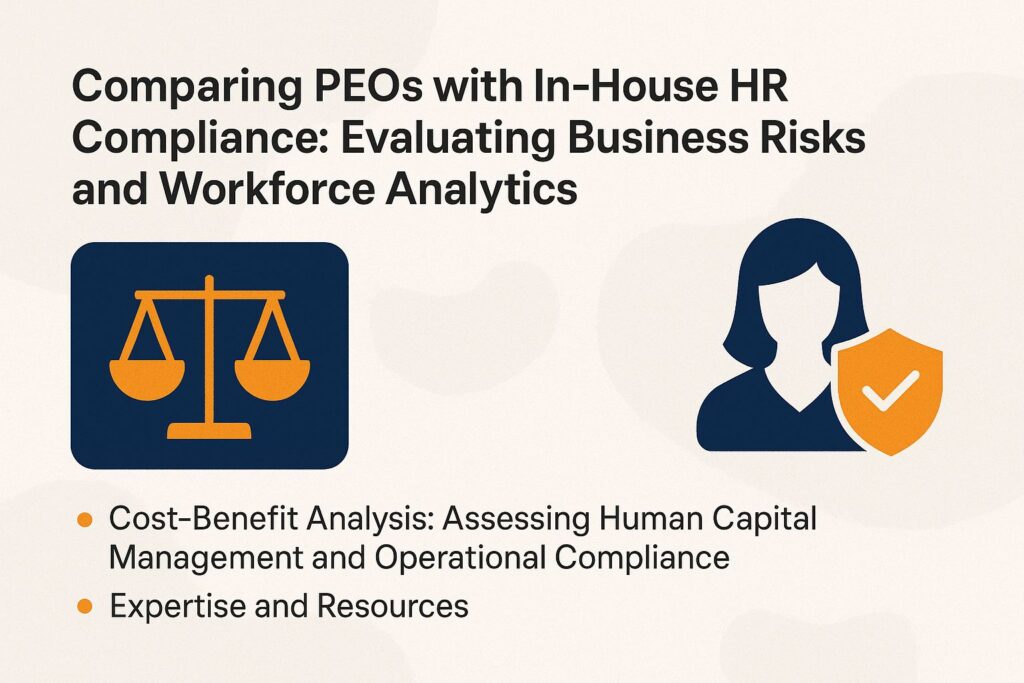
Looking at PEO services versus managing HR compliance internally helps businesses decide which option works best for them. Does employing a PEO replace your company’s HR department entirely? This question is fundamental in evaluating the extent of integration and reliance a business might need on external HR services.
Cost-Benefit Analysis: Assessing Human Capital Management and Operational Compliance
Looking at the costs and benefits shows that PEOs can help businesses save between 20% to 40% on HR costs compared to managing HR internally.
For instance, if a company’s in-house HR costs total $100,000 annually, switching to a PEO might reduce those expenses to between $60,000 and $80,000.
This includes savings on payroll processing fees, benefits administration, and compliance burdens.
To illustrate, if you typically spend $15,000 on benefits, a PEO might offer a package for only $10,000 due to their collective buying power.
Over three years, this change can lead to significant savings, potentially amounting to $90,000 or more, allowing businesses to reinvest in growth initiatives.
Expertise and Resources
PEO services often offer access to expert skills and HR technology tools that small businesses find hard to get on their own.
This knowledge covers key areas like following legal rules, HR management, managing staff, and handling employee benefits compliance.
For example, a PEO can help follow labor laws and wage and hour laws correctly, lowering the risk of expensive labor audits and fines.
They usually provide complete benefits packages, including health insurance and retirement plans, which small and medium-sized businesses might find hard to offer independently, ensuring compliance with IRS guidelines.
By outsourcing payroll processing to a PEO, businesses can avoid errors and save time, allowing them to focus on core operations. This method can greatly improve a company’s productivity and employee happiness.
Best Practices for Choosing a PEO
It’s important to follow HR best practices when picking a PEO.
Choosing a suitable PEO helps businesses work with a provider that matches their specific needs and objectives.
Questions to Ask Potential PEOs
When interviewing potential PEOs, businesses should ask targeted questions to understand their services, fees, and compliance capabilities.
- Start by asking how they manage compliance training, like staffing rules, to learn about labor laws.
- Ask how they handle client support and audit support: is it a dedicated representative or a general hotline?
- Questions about their technology platform can reveal how user-friendly their systems are for payroll and reporting. Make sure to check their pricing details, including any extra fees.
- Knowing their employee onboarding process and benefits will make sure they fit your company’s needs.
Assessing PEO Technology and Tools
Evaluating the technology and tools used by PEOs is essential for ensuring they can effectively manage compliance and HR functions.
Tools such as Paychex Flex make handling payroll and tracking compliance easier, making them very practical for PEOs.
Consider evaluating based on key criteria such as user interface, integration capabilities with existing systems, HR analytics, and customer support quality.
For example, Paychex Flex offers easy-to-use dashboards that help companies handle employee information and payroll smoothly. ADP Workforce Now is another strong contender, particularly for larger organizations, as it offers advanced analytics features.
In the end, the best choice should match the business requirements and support growth.
PEO Services and Compliance Tracking: What’s Next
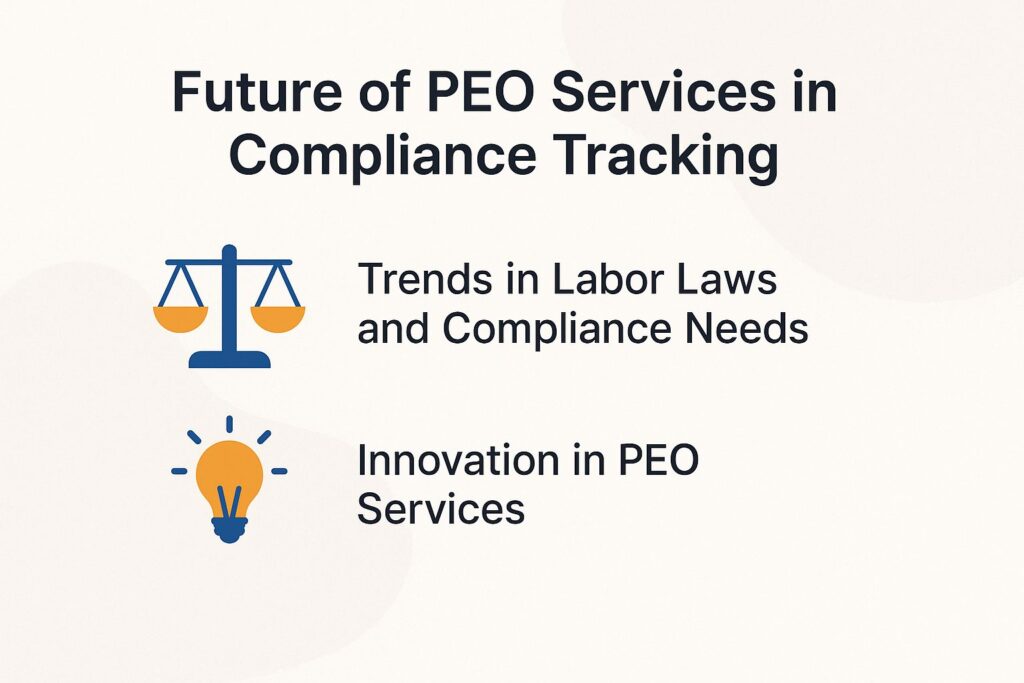
PEO services will rely more on HR technology to improve compliance tracking and keep up with changing labor laws and international labor laws. Additionally, understanding how PEOs can facilitate talent acquisition can provide a strategic edge in adapting to these changes.
Trends in Labor Laws and Compliance Needs
Emerging labor laws are reshaping compliance needs, with recent trends indicating increased employee protections, taxation challenges, and stricter regulations.
One significant trend is the rise of remote work regulations, which require employers to address issues such as data security and employee monitoring. Businesses should check their rules to make sure they follow state laws, which can differ greatly.
For instance, tools like Gusto or OnPay can help manage payroll considerations for remote employees across different jurisdictions. Resources from the Society for Human Resource Management (SHRM) offer current guidelines on handling these changes while maintaining workplace culture and productivity.
Innovation in PEO Services
New developments in PEO services, such as AI-powered tools for monitoring compliance and improved platforms for involving employees, are changing how companies handle HR tasks.
For example, tools like Gusto and Justworks use AI to check compliance data instantly, allowing quick changes to policies and practices.
By using platforms like Officevibe or TINYpulse, PEOs can increase employee engagement with feedback tools and surveys. This proactive method finds problems early and encourages open communication.
Implementing these technologies can lead to increased retention rates, improved employee satisfaction, and compliance with union regulations, thereby enhancing overall workplace productivity.
Written by Carol Sanders
Harvard University graduate with a degree in psychology and human resources.
Owner of a PEO consulting firm in Massachusetts and contributing writer for PEO Costs.
